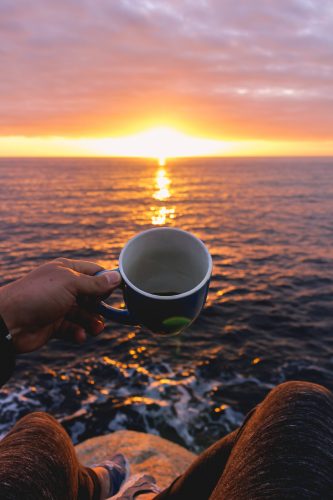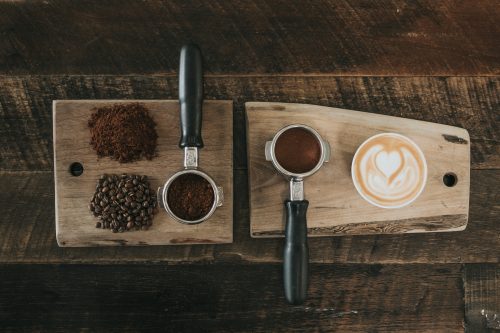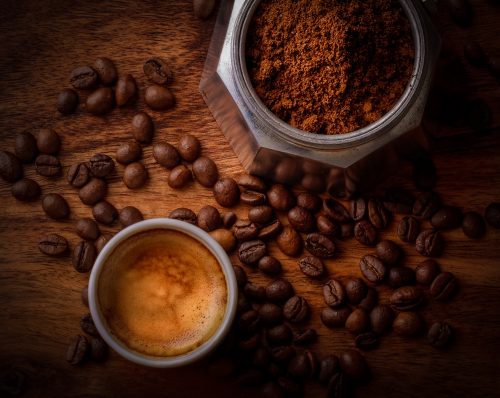
Coffee is an integral part of life. Whether it’s used for perking up in the mornings, keeping motivated to get through the day, or just enjoying it for the flavor profile it presents, coffee is one thing that people the world over have in common.
The selections of coffees are endless; however, one of the most sought after is Sumatra coffee. This coffee has a very different taste and texture to it than the average coffee, and it is harder to find pure Sumatra, with a lower amount of annual coffee production.
Grown in Sumatra, Indonesia, and subject to its weather patterns, three types of beans fall under the umbrella of Sumatra coffee beans. This coffee has a lot more to offer than just flavor.
Check out my personal recommendation of Copper Moon Sumatra Mandheling coffee on Amazon by clicking here. With over a 100 reviews, and my own personal addiction to it, you can’t go wrong (esp. the sweet pricing!) Of course, we have other regional coffees (like from Lake Toba) so check out all of our recommendations below:
It offers an interesting history and origin story, and it’s the insight into the harvest and process that makes it so different from other types of coffee, as well as the brilliant taste. Take a glimpse into Sumatra coffee, where it came from, and why it’s so sought after. Before we delve deep, we will be discussing the most delicious, best Sumatra coffee beans (low acidity!) and brands you can purchase!
PS. This particular type is also called Sumatran coffee.
Best Sumatra Coffee Brands – It’s More Than “Just A Name”…

Sumatra coffee comes in three types: Mandheling, Lintong, and Gayo, so tastes will determine what brands are preferred. Lintong, a lesser known type from the District of Lintong Nihuta, is grown on a high plateau.
Its best known for its full body (dark roast), concentrated flavor profile of herbal notes, spicy and rich aftertaste, accompanied by a chocolate flavor.
It’s also erroneously associated with the Kopi Luwak type of Sumatra. However, they are unrelated, as the Kopi Luwak coffee bean undergoes a much different processing method.
Gayo is grown on the Gayo highlands of Central Aceh, and is revered as having the cleanest taste of all Sumatran coffees, due to its special handling during the processing method. It boasts of a well balanced body, with fruity and herbal flavors.
Grown in North Sumatra, Mandheling has low acidity, a light, earthy aroma, and the flavor is described as chocolatey, woody, herbal with earthy flavor. It is considered by many to be the best of the three. If you enjoy a dark roast, full body coffee, you can’t go wrong with this option!
Sumatra Mandheling Coffee – One of The Most Popular Varieties
What most know as best Sumatra coffee is the Mandheling variety of the bean. It comes as no surprise, due to the nature of its flavor, aroma, and the ease of harvesting, compared to its counterparts, Lintong and Gayo.
Sumatra Mandheling coffee is easy to find, both online and in physical locations such as Wal-Mart, Target, Starbucks, Amazon and independent coffee houses and various specialty stores, due to the world-renown fame it enjoys.
As the main variety of Sumatra, it can be purchased nearly anywhere for varying prices, according to the quality of the product. When looking for the best Sumatra coffee brands, Volcanica is rated the highest, offering both ground and whole bean options for purchase.
Gayo can also be purchased through this company, and appears usually as a blend in coffee shops and online, so it is much less recognized for its unique flavor and tones, and is slightly more expensive.
A Little Background On Sumatra Coffee Brands & Its Growth

Sumatra is the largest island in the Indonesian archipelago, with several active volcanoes, and has three major specialty coffee regions: Tapanuli, Lintong Nihuta, and Gayo.
Despite unpredictable weather, the tropical climate and beneficial location near the equator make Sumatra ideal for coffee plantations.
The mountainous areas in the interior serve to create micro climates for the coffee’s growth and production, from planting and harvest, through processing and preparation.
In addition to this, the production of hundreds of thousands of tons of coffee, annually, is in the hands of a small group of cooperatives and farmers. Due to the small groups of production, it is a commodity, and as a result, is very desirable.
Today, Sumatra is the home of one of the most popular coffees in the world, but it had its humble beginnings as an import into Indonesia.
The Sumatra coffee beans are identified not just by the fact that it resides in Sumatra’s western-most island, but by the bluish-green color at the raw bean stage that suggest a lack of iron in the soil.
The flavor is brought out in the wet hulling processing phase of the bean (with a much higher moisture content), unique among the various forms of processing coffee beans around the world.
While it is typically associated with a smooth taste and sweet body, the best Sumatra coffee beans pick up the flavor of the region they are grown in.
Historical Humble Beginnings of Sumatra Coffee
During the 17th century, the Typica coffee plants (mainly found in the regions of Bergandal and Sidikalang), the precursors to the Sumatra coffee beans, were brought to Indonesia by the Dutch East India Company. They were looking to break the monopoly that the Arab merchants held on the coffee trade at the time.
The Dutch Colonial Government ruled the majority of the region after finding the islands suitable for commercial crops, and began experimenting with planting in Batavia (present day Jakarta), with some of the plants taking hold.
In 1711, the first green coffee exports were sent to Europe, and with that success, within ten years, the exports were up to sixty tons per year.
Indonesia, from then on, became the largest producer of coffee after Ethiopia and Arabia, and was Dutch East India Company until the 1790’s.
By the 1870’s, coffee plantations dotted the Indonesian islands of Java, Sumatra, and Sulawesi, and encouraged industrial evolution, such as the building of trains and roads to match the supply with demand for the coffee.
At the end of the 19th century, the Sumatra coffee plant was all but wiped out by leaf rust disease, as was its attempted replacement of Liberica coffee.
Robusta coffee was experimented with next, took hold, and is now 75% of Indonesia’s coffee export, mainly from the southern end of Sumatra. Lake Toba and other regions in Sumatra produce some of the most flavorful coffee beans you’ll ever consume!
PS Lake Toba is the largest volcanic crater lake in the world!
Best Sumatra Coffee Beans Hold A Subtle & Gentle Flavour

Sumatran coffees are much loved, not because it presents a largely robust and bright flavor, but rather because the flavor is more subtle than others. The acidity is generally lower, but it does have its exceptions.
These exceptions are expressed in the different types of Sumatra coffee, and gain slightly different flavors to enjoy, due to the locations they are harvested from.
Considered an Arabica coffee due to its low acidity, it produces the sweeter flavors that range from maple syrup, toasted almond, to grapefruit or sweet fruity notes.
The sweeter, gentler taste and smell of Sumatra coffee beans is due largely, in part, to the processing it undergoes, from harvest to preparation and packaging.
A Different Approach With Sumatra Coffee Beans
Sumatra coffee comes from an island in Indonesia, where they use a processing method called “wet-hulling” (or Giling Basah) is used to process the beans because of the unpredictable weather. This leaves less time to dry the beans, leaving them with 50% of their moisture before they are processed by machine…. this means that these beans are left with a much higher moisture content.
Sidenote: Wet hulling is distinct from natural processing methods used in Ethiopia and other parts of the world and can be falsely referred to as natural or dry processed.
This allows them to ferment in the processing method, and gain that complex earthy flavor and lower the acidity and bitter taste.
Coffee beans grown in places like Africa and South America have other processing methods and preparation, including wet, dry, and semi-dry.
However, those coffee beans are left with 9-11% of their moisture, producing a stronger flavor and higher acidity, despite the similar processes of preparation of the beans.
Sumatra, as an arabica coffee, tends to have a sweeter, softer taste to it; robusta beans have a stronger, harsh and nutty aftertaste.
Containing twice as much caffeine as arabica coffee beans, robusta beans are more valued for their deep flavors, especially with espresso.
Sumatra Coffee Beans Have A Different Taste
Lintong is much more difficult to find, with the internet being the primary source of supply, outside of Indonesia. There is no real explanation as to why this strain doesn’t enjoy the same popularity as Mandheling and Gayo Mountain; however, the Lintong is no less enticing, and is an interesting flavor that should be experienced.
Northern Tea Merchants provides a more expensive, but higher quality product. It comes as a Lintong-only coffee, with no blends of the other two.
Amazon carries Lintong under an expensive brand called Wild Kopi Luwak, and a cheaper brand called Aspen Sierra Coffee Roasting Co.
Overall, the best locations for finding Sumatra coffee depends on personal preference and level of experience desired in the coffee.
Volcanica, Starbucks, and exclusively online shops such as Northern Tea Merchants, all carry Sumatra coffee types. The determining factor for which coffee tastes best is the palate of the customer, and the preparation process by the vendor.
Sumatran Vs Colombian Coffee: What’s Are The Differences?
If you are a coffee lover, then you probably already know the difference between Colombian coffee and Sumatran coffee. But if you are new to the world of fine coffee, you might be wondering what sets these two coffee types apart.
Today, we are going to explore both of these amazing coffee beans, and learn what makes them different from one another.
The Hulling Process
One of the main differences between Colombian coffee and Sumatran coffee is how they are processed. Colombian coffee is dried in the sun for several days after, or until they reach a moisture level of around 10%. This helps the bean dry out and gets it ready for the hulling process.
But, when it comes to Sumatran coffee, it spends a lot less time in the sun. Sumatran coffee is hulled with a much higher moisture level, which can be around 20%.
A special wet hulling machine is used to remove the beans from the parchment (again, not dry processed). The wet hulling machine also allows the coffee beans to ferment, which gives them a unique flavor that you will not find anywhere else.
Acidity Level And Flavor
Colombian coffee has a well-balanced flavor, and contains a medium amount of acid. This coffee still has some bite to it, but it is not overwhelmingly bitter.
Some coffee lovers consider Colombian coffee one of the world’s best, because of its smooth flavor. On the other hand, Sumatran coffee has a much lower acid level. This makes it one of the best coffees for those who are sensitive to acid.
Sumatran coffee also has a very unique flavor. It has earthy notes that help it stand out from the rest. When you drink Sumatran coffee, you will notice hints of bell pepper, mushrooms, and even herbs. This flavor is caused by the way the coffee is processed, and the soil in which it grows.
The Price
When it comes to price, you will notice a big difference between these two coffee beans. Colombian coffee is much cheaper than Sumatran coffee, for several different reasons.
First, Colombian coffee is more widely grown, and there are more regions that produce it. Sumatran coffee, on the other hand, has a much smaller growing region, which is located in more remote areas.
Second, as we have already learned, Sumatra coffee goes through a different hulling process that requires more labor. This can often drive up the price of the bean.
Finally, Sumatran coffee is harder to source than Colombian coffee. While local trade groups are working to gain more access to coffee grown in Sumatra, it is simply harder to come by.
Each of these coffee beans have something different to offer. Both of them are highly sought after, and each one provides excellent flavor. While one is a bit more acidic than the other, both of these coffees have a smooth taste that you are sure to love!
If you have never tried these coffees before, you should go out and get you a couple of bags. You really don’t know what you are missing!
End Your Journey With a Mug of the Sumatra Mandheling Coffee!
Sumatra coffee is much more than a bean that comes from Indonesia. It’s a legacy with a history as rich as its flavor, and it has a foothold in the modern era where neither war nor plight could stop its growing popularity, and from rising to where it is today.
The history, the taste of the regions found in the coffee itself, and the intriguing differences in the regions are what’s truly amazing.
A new understanding of Sumatran coffee beans is ground in, brewed to perfection, and served with notes of history of where the plant originated, and how it’s changed. The different processes that give us the finished product coffee beans are what makes this island’s coffee special. Go ahead, grab a delicious mug of Sumatra Mandheling coffee and call it a beautiful day!